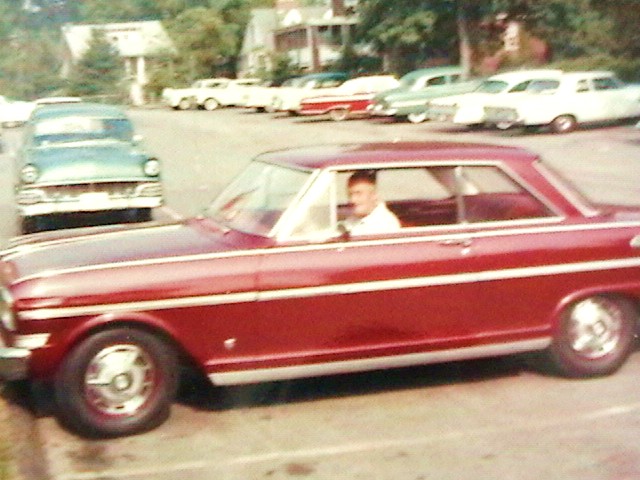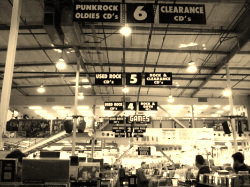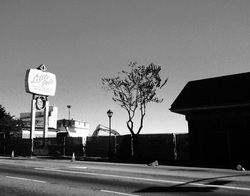Because we now live in the age of Google, the instant I thought of my grandparents' pink kitchen, I Googled "pink kitchens" and learned a) that pink was a popular mod color, b) once upon a time you
could buy almost anything in that shade, and c) there are people today who love that color, particularly in vintage kitchens, and those aficionados have created Pinterest pages devoted to mod pink kitchens.
Naturally I clicked a link and proceeded immediately to Pinterest, and there viewed a variety of pink-painted vintage kitchens, as well as pink refrigerators and pink blenders and pink
dishes. I had a strange sense of traveling through time because, as stated above, this was a very specific shade of pink. Gazing at the "pink kitchen" pictures on Pinterest, I returned to my grandparents' old kitchen via memories that were more textured and three-dimensional than any I had conjured before consulting the Pinterest pages.
I am a recent convert to Pinterest. A month ago a friend and fellow author (Jack Witt, "Cut, Cool & Confident" and "Tight, Tone & Trim") suggested that I create a Pinterest site for inspiration and to promote my books. Jack's advice is usually spot-on, so I created a Pinterest site (it was quite simple) and then a few "boards". The concept of Pinterest--a highly visual environment--is that you post or search for images (sketches, paintings, or photos) of items that interest you, and you then "pin" each image to a "board". If you like soccer,
for example, Pinterest allows you to "pin" your own soccer photos, and others' soccer images, to a virtual corkboard that you name something such as "Soccer". Other Pinterest users--called "Pinners"--can view your boards (unless you designate them as "Secret" and allow access only to friends). Other Pinners can "favorite" and "share" and "pin" your images. Theycan follow your "boards" and you can follow their "boards".
Pinterest won me over quickly. It was simple and intuitive to set up, and simple and intuitive to create boards. At its most basic level, it's like a virtual scrapbook. If you like the theater, you can pin images of theater marquees, posters, press releases, and cast photos. It you like a certain city--let's say, for example, Philadelphia--you can pin images of its landmarks, landscapes, and famous people. If you like jazz, let the jazz-image pinning begin!
For visual people--and most of us are, to some degree or another; it's hard-wired into us to help us recognize and elude danger--Pinterest rapidly becomes more addictive than, well, anything else
(name your poison). Once you create your boards and populate them with images, you want to find more images. And then more. Pinterest is a deep, deep rabbit hole that branches off in myriad directions. The images you encounter suggest other images, and even other boards. Like a hunter stalking its prey or an artist pursuing a muse, you scour Pinterest for that perfect image of, say, a ballet slipper. Or a banjo. Or a Peruvian basekt. Or a Christmas tree in the snow. Or an Irish Setter. There are so many things to seek and collect, and each discovery sparks another idea. Before you know it hours have passed and you have created multiple boards and collected hundreds--even thousands--of images.
At its most basic, Pinterest is a virtual scrapbooking site. But it quickly grows to much more than that. Before you know it, you are a gallery, even a museum, curating collections. The
"boards" become collections and rooms and wings of your virtual gallery, your virtual museum. Pinning is an exciting and rewarding endeavor, and when you have completed each hunter-gatherer-curator session, you actually have something to show for it. Something instructive. Something beautiful. Something moving, even.
And so I pen this blog, a complete and unapologetic Pinterest addict--although I prefer the term "curator". And I encourage you to join the Pinner ranks. Pinterest is free, simple, educational, and inspirational. It will give you ideas for your own projects, whether you are an artist, mom, mechanic, gardner, musician, athlete, or historian. It will give you a forum to collect your favorite images of bottle caps or fans or gardens or statues or parkour moves or jars of jam or Civil War battlefields--anything that interests you, anything you care to imagine. And it allows you to share all the wonders that you collect, your Aladdin's caves of treasure, with other Pinners and
even with non-Pinners (who are allowed limited yet intoxicating glimpses of the visual riches Pinterest holds).
Perhaps most wonderfully of all, Pinterest can transport us to other times and places. A cafe in Paris. A library in London. A garden in Tokyo. A farm in the 1920's heartland. Anywhere. Even to our own pasts. As when I view a snowy street in Germany. Or pink kitchens like the one in which my grandparents' cooked for us and made us laugh.
We do indeed live in an amazing age, a nearly magical age. The world comes to our computers, and we can find and create and share beauty with everyone around the globe. It is a new era. An age of Pinteresting times.
[You can follow the author's Pinterest boards at http://www.pinterest.com/leslemonauthor.]



 RSS Feed
RSS Feed
